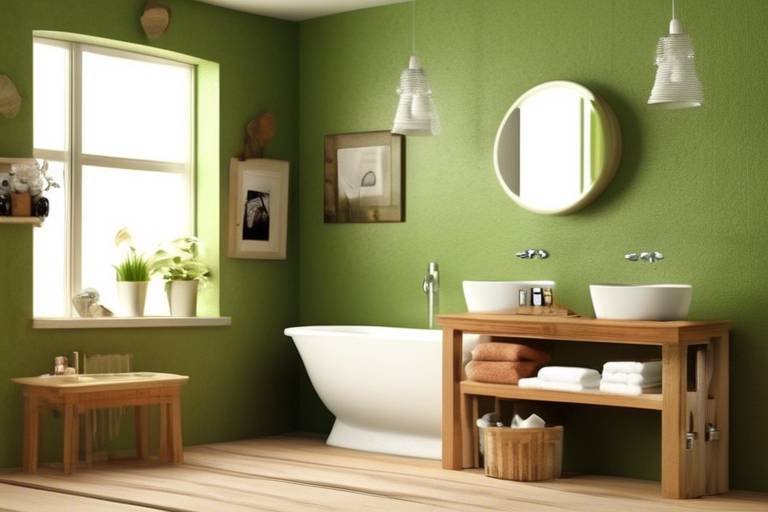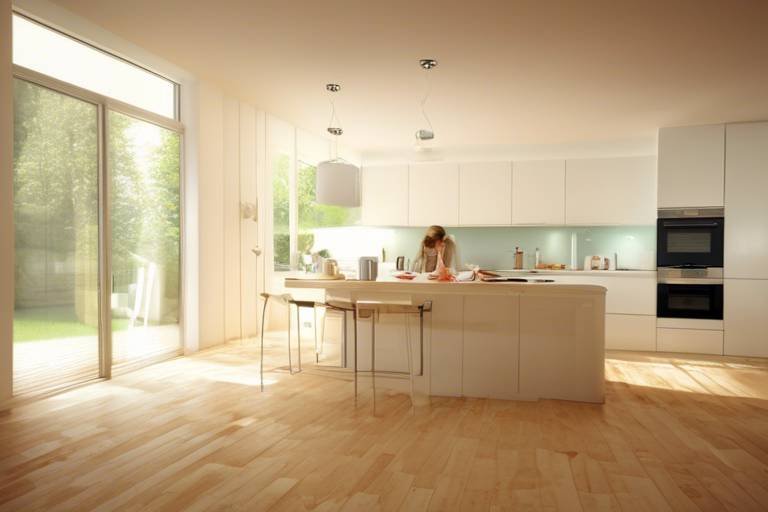How to Sustainably Upcycle Old Furniture
Are you tired of looking at that old, worn-out furniture in your home, wondering if it’s time to toss it out? Well, hold your horses! Before you send it off to the landfill, consider the exciting world of upcycling. This creative process not only gives your furniture a new lease on life but also helps reduce waste and promotes sustainability. Imagine transforming that rickety chair or scratched-up table into a stunning centerpiece that reflects your personal style. Sounds intriguing, right? In this article, we’ll explore practical tips and techniques to help you sustainably upcycle old furniture, turning it into beautiful, functional pieces that you can proudly show off.
So, what exactly is upcycling? In simple terms, it’s the practice of taking something old and giving it a new purpose, often in a way that enhances its value. Unlike recycling, which breaks down materials to create something new, upcycling keeps the original item intact while improving its functionality or aesthetics. This creative reuse is essential in our fight against waste, as it encourages us to think outside the box and see potential where others see junk. By upcycling, we not only reduce the demand for new products but also contribute to a more sustainable future.
Now that you’re excited about upcycling, how do you choose the right pieces to transform? Not all furniture is created equal when it comes to upcycling. Look for items that are sturdy and have good bones; think of them as the foundation of your creative project. Consider the material—wood is often a favorite for upcycling due to its durability and versatility. Also, take a moment to assess the condition of the piece. If it's solid but just needs a little TLC, you’re on the right track!
Before diving into your upcycling adventure, it’s crucial to assess the condition of your chosen furniture. Start by examining its structural integrity. Is it wobbling? Are there any cracks or loose joints? These factors will determine how much work you need to put into repairs. Remember, a strong foundation is key to a successful upcycle!
Addressing structural problems is vital for both safety and longevity. Common repairs might include fixing loose joints or reinforcing weak areas. For instance, if you find a chair with a wobbly leg, don’t hesitate to tighten the screws or use wood glue to secure it. Think of this step as giving your furniture a little workout before its big transformation!
Once your furniture is structurally sound, it’s time to roll up your sleeves and get to work on cleaning and preparing the surface. Old finishes, dirt, and grime can interfere with your upcycling project, so a thorough cleaning is essential. Use a mixture of soap and water to scrub away the dirt, and consider using a chemical stripper if you need to remove old paint or varnish. This preparation is like priming a canvas before painting—it sets the stage for your masterpiece!
Now comes the fun part: brainstorming creative upcycling ideas! The possibilities are endless, and you can let your imagination run wild. Here are just a few inspiring projects to get your creative juices flowing:
- Turn an old dresser into a stylish TV stand: With a little sanding and paint, you can create a modern entertainment center.
- Transform wooden pallets into outdoor furniture: Stack and sand them down for a rustic seating area.
- Repurpose an old ladder into a bookshelf: A little paint and some shelves can turn a ladder into a unique storage solution.
These projects not only breathe new life into old furniture but also allow you to express your personal style.
Before you start your upcycling journey, make sure you have the right tools and materials. Having the essentials on hand will make your projects smoother and more enjoyable. Here’s a quick rundown of what you might need:
Some of the must-have tools for upcycling projects include:
- Sandpaper: Essential for smoothing surfaces.
- Paintbrushes: For applying paint or finishes.
- Screwdriver: Useful for tightening or removing screws.
- Measuring tape: Ensures your modifications fit perfectly.
When it comes to materials, choosing sustainable options is key. Look for eco-friendly paints and finishes that are low in volatile organic compounds (VOCs). These materials are not only better for the environment but also for your health. Additionally, consider using reclaimed wood or recycled textiles to give your projects an extra dose of sustainability.
Finally, the finishing touches can truly elevate your upcycled furniture. Whether you’re painting, staining, or sealing, these steps will ensure your final product is not only beautiful but also durable. Take your time to choose colors and finishes that complement your style, and don’t be afraid to experiment! After all, this is your chance to create something uniquely yours.
Q: What types of furniture are best for upcycling?
A: Look for sturdy pieces made of wood or metal that can be easily repaired or modified.
Q: Do I need special skills to upcycle furniture?
A: Not at all! Many upcycling projects are beginner-friendly, and there are plenty of resources available to help you learn.
Q: Can I upcycle furniture without painting it?
A: Absolutely! You can use techniques like reupholstering, adding new hardware, or simply refinishing the wood to give it a fresh look.

Understanding Upcycling
Upcycling is an innovative and creative approach to breathing new life into old items, particularly furniture. Unlike recycling, which often breaks down materials to create something new, upcycling transforms existing products into something better or of higher value. It’s all about enhancing the original piece rather than discarding it. Imagine turning an old wooden chair into a stylish plant stand or a vintage dresser into a chic bathroom vanity. This not only helps in reducing waste but also allows for a unique expression of personal style.
One of the most significant benefits of upcycling is its role in promoting sustainability. With the growing awareness of environmental issues, more people are seeking ways to minimize their carbon footprint. By choosing to upcycle furniture, you’re participating in a movement that encourages creative reuse, ultimately leading to less waste in landfills. Furthermore, upcycling can save you money, as you often only need to invest in a few supplies to transform a piece rather than purchasing something brand new.
Moreover, the emotional connection to upcycled items often adds to their charm. Each piece tells a story, and when you invest time and effort into transforming an old item, it becomes a part of your home’s narrative. It's like giving a second chance to a forgotten treasure, allowing it to shine once again. Upcycling also fosters a sense of accomplishment; there’s something incredibly satisfying about seeing the fruits of your labor manifest in a beautiful, functional piece of furniture.
In essence, understanding upcycling is about recognizing the potential in what we already have. It’s a call to action for individuals to think creatively and critically about consumption and waste. By embracing upcycling, we not only contribute to a more sustainable future but also create unique, personalized pieces that enhance our living spaces. So, the next time you consider tossing out an old piece of furniture, pause and ask yourself: What can I create from this?

Choosing the Right Furniture
When it comes to upcycling, choosing the right furniture is like picking the perfect canvas for your masterpiece. Not all pieces are created equal, and some are just waiting for a little creativity to shine again. The first thing to consider is the material of the furniture. Solid wood, for example, is a fantastic option for upcycling due to its durability and timeless appeal. On the other hand, particle board or flimsy plastic might not hold up well under the pressure of transformation. So, look for pieces made from materials that can withstand a bit of love and labor.
Next, think about the condition of the furniture. Is it structurally sound? Are there any major damages that need addressing? A well-loved piece might have its quirks, but if it’s too far gone, you may want to reconsider. Check for signs of wear and tear, but don’t shy away from pieces that just need a little TLC. Sometimes, a scratch or a dent can add character and tell a story. Remember, the goal is to give it a new life, so be on the lookout for pieces that have potential.
Another aspect to consider is the functionality of the furniture. Think about how you want to use the piece after it’s transformed. Do you want a stylish coffee table, a chic storage solution, or perhaps a statement chair? Keep in mind the space you have available and how the new piece will fit into your home. The best upcycling projects are those that not only look good but also serve a purpose in your daily life.
Lastly, don’t forget about your personal style. Upcycling is a chance to express yourself and create something that reflects your taste. Consider pieces that inspire you or resonate with your aesthetic. Whether it's a vintage dresser that needs a splash of color or an old chair that could use a cozy new cushion, the right piece is out there just waiting for your creative touch.
In summary, here are the key points to keep in mind when choosing the right furniture for upcycling:
- Material: Look for durable options like solid wood.
- Condition: Assess structural integrity and potential for repair.
- Functionality: Consider how the piece will fit into your space.
- Personal Style: Choose pieces that resonate with your aesthetic.
By carefully selecting the right furniture, you can ensure that your upcycling project is not only successful but also a reflection of your unique taste and creativity. So, grab your tools and start hunting for that perfect piece—you never know what amazing transformation awaits!

Assessing Condition
Before diving headfirst into your upcycling project, it's crucial to assess the condition of the furniture you plan to transform. Think of this as the foundation of a house: if it's shaky, no matter how beautiful your decor is, the whole structure could come crashing down. Start by examining the piece thoroughly. Look for signs of wear and tear, such as scratches, dents, or loose joints. These imperfections can often be fixed, but they do require attention before you can proceed with your creative vision.
One of the first steps in assessing condition is to check for structural integrity. Gently shake the furniture to see if it wobbles or feels unstable. If it does, you may need to reinforce it before applying any paint or finishes. Pay special attention to joints, legs, and any areas that bear weight. If you notice any issues, make a note of them; they can often be repaired with basic tools and a little know-how.
Next, consider the material of the furniture. Is it solid wood, particleboard, or perhaps metal? Solid wood pieces are generally more durable and easier to work with, while particleboard might require extra care, especially if it has water damage. For instance, if you find a lovely old dresser made of solid oak, it might just need a good sanding and a fresh coat of paint to bring it back to life. On the other hand, a particleboard piece with significant damage might not be worth the effort.
Once you've evaluated the structural aspects, take a moment to assess the surface condition. Is the finish chipped or peeling? Are there stains that seem impossible to remove? A clean and smooth surface is essential for a successful upcycling project, as it allows for better adhesion of paints and finishes. If the surface is rough or damaged, you may need to consider stripping the old finish or sanding it down to create a fresh canvas.
In summary, assessing the condition of your furniture involves a thorough inspection of both its structural integrity and surface quality. By paying close attention to these details, you set yourself up for a successful and enjoyable upcycling experience. Remember, the goal is to breathe new life into these pieces while ensuring they remain functional and safe for use.
- What should I look for when assessing old furniture? Focus on structural integrity, surface condition, and the type of material used in the furniture.
- Can I upcycle furniture that has significant damage? Yes, but be prepared to invest time and effort into repairs. Some damage can be fixed, while others may not be worth the effort.
- How do I know if a piece is worth upcycling? If it has solid construction and the potential for creative transformation, it’s likely worth the effort. Look for pieces that inspire you!

Repairing Structural Issues
When it comes to upcycling furniture, addressing structural issues is crucial. Imagine trying to breathe new life into a beautiful old chair, only to find that it wobbles precariously. Not only can this be frustrating, but it can also pose safety risks. Before you dive into painting or reupholstering, take a moment to assess the furniture's structural integrity. Look for signs of damage such as loose joints, cracks, or broken parts. These issues need to be resolved to ensure that your upcycled piece is not only aesthetically pleasing but also safe and functional.
One common issue you might encounter is loose joints, which can often be fixed with wood glue. Simply apply the glue to the joint, clamp it until it sets, and voilà! Your piece is back in action. For more severe problems, like a cracked leg or a broken frame, you might need to use wood filler or even replace the damaged part entirely. Don’t be afraid to get creative with your repairs; sometimes, adding a decorative bracket or a unique support can enhance the piece's character.
Another aspect to consider is reinforcing weak areas. If you notice that a piece is sagging or has a weak spot, consider adding some supportive bracing. This could be as simple as adding a cross brace on the underside of a tabletop or installing corner brackets to stabilize a cabinet. Such modifications not only strengthen the furniture but can also add a unique touch to your project.
Before you start any repairs, gather the necessary tools. Here’s a quick table of essential tools that can help you tackle structural issues:
| Tool | Purpose |
|---|---|
| Wood Glue | For bonding loose joints |
| Clamps | To hold pieces together while glue dries |
| Wood Filler | To fill in cracks and holes |
| Screwdriver | For tightening or replacing screws |
| Drill | For making new holes or reinforcing joints |
Once you've addressed the structural issues, you'll be amazed at how much more stable your furniture feels. This foundation is crucial for a successful upcycling project, as it allows you to confidently move on to the fun part—adding your personal touch!
- What are common structural issues in old furniture? Common issues include loose joints, cracks, and broken parts.
- Can I repair furniture without professional help? Yes! Many structural repairs can be done with basic tools and materials.
- How do I know if a piece is worth repairing? Consider the quality of materials and the overall design; if it has good bones, it's worth saving!
- What tools do I need for structural repairs? Essential tools include wood glue, clamps, wood filler, a screwdriver, and a drill.

Cleaning and Preparing
When it comes to upcycling old furniture, the piece is a crucial step that sets the foundation for a successful transformation. Imagine trying to paint a canvas that’s covered in dust and grime; the results would be far from stunning! Similarly, your furniture deserves a clean slate to showcase its new look. Start by removing any dust, dirt, or old wax using a soft cloth or a vacuum cleaner with a brush attachment. This not only helps in achieving a smoother finish but also allows you to inspect the furniture for any hidden imperfections.
Next, you might encounter old finishes like varnish or paint that need to be stripped away. For this, a good quality furniture stripper can be your best friend. Apply the stripper according to the manufacturer’s instructions, and use a putty knife to gently scrape off the old finish. Remember, patience is key here; rushing through can damage the wood beneath. After stripping, it’s essential to wash the furniture thoroughly with soap and water to remove any residue from the stripper. Rinse it well and let it dry completely.
Once the furniture is clean, it’s time to prepare the surface for painting or staining. This involves sanding the piece to create a smooth surface that allows for better adhesion of the new finish. Use a medium-grit sandpaper to start, and then move to a finer grit for a polished touch. If you encounter any deep scratches or dents, don’t fret! They can often be filled with wood filler, which you can then sand down to match the surrounding area. After sanding, wipe the furniture down with a damp cloth to remove any dust particles. This is a vital step because even the tiniest speck of dust can ruin the final finish.
Lastly, consider applying a primer if you plan to paint the furniture. Primer acts as a barrier between the old and new finishes, ensuring that the paint adheres better and lasts longer. Choose a primer that is suitable for the type of paint you will be using—water-based or oil-based. Once primed, let it dry completely before moving on to the fun part: decorating your newly prepared canvas!
- What is upcycling? Upcycling is the process of creatively reusing old items to create something new and valuable, thereby reducing waste.
- How do I know if my furniture is suitable for upcycling? Look for pieces that are structurally sound but may need a cosmetic update. Solid wood furniture often makes the best candidates.
- Can I upcycle furniture without prior experience? Absolutely! Many upcycling projects are beginner-friendly, and there are plenty of resources available to guide you.
- What tools do I need for upcycling? Basic tools include sandpaper, paintbrushes, a putty knife, and a vacuum cleaner. As you advance, you may invest in more specialized equipment.

Creative Upcycling Ideas
When it comes to upcycling old furniture, the possibilities are truly endless! Imagine taking a worn-out dresser and transforming it into a stunning entryway bench or turning an old ladder into a charming bookshelf. Upcycling is not just about giving your furniture a facelift; it’s about breathing new life into pieces that might otherwise end up in a landfill. Here are some creative ideas to get your imagination flowing:
First off, consider the classic coffee table makeover. If you have a table that has seen better days, think about painting it in a bold color or adding a fun design using stencils. You might even want to replace the top with a piece of reclaimed wood for that rustic charm. This not only enhances the aesthetics but also gives the table a new purpose, perhaps as a storage unit by adding baskets underneath.
Another fantastic project is to turn an old chair into a unique garden planter. By removing the seat and adding a planter box in its place, you can create a whimsical piece that adds character to your outdoor space. Just imagine how delightful it would be to see flowers blooming from a chair that once sat inside your home!
If you’re looking for something a bit more functional, consider transforming a bookshelf into a stylish bar cart. With a little bit of paint and some added wheels, you can create a mobile drink station that’s perfect for entertaining guests. It’s a fun way to repurpose something that might otherwise collect dust and can serve as a great conversation starter at your next gathering.
For those who love the industrial look, an old wooden pallet can be turned into a trendy coffee table or even a rustic bed frame. Pallets are versatile and can be customized to fit any style. You can sand them down, stain them, or even paint them to match your decor. The best part? Pallets are often available for free or at a very low cost!
Lastly, don’t underestimate the power of upcycling small items. Old picture frames can be transformed into message boards by adding corkboard or fabric. You can also repurpose glass jars into stylish candle holders or storage containers. These little projects can make a big impact and are perfect for adding personal touches to your home.
In conclusion, the world of upcycling is filled with opportunities to express your creativity while being kind to the planet. Each piece of furniture has a story to tell, and with a bit of imagination and effort, you can give it a new chapter. So, roll up your sleeves, gather your tools, and start your upcycling adventure today!
Here are some common questions people have about upcycling furniture:
- What is the difference between upcycling and recycling? Upcycling involves creatively transforming an item into something of higher value or quality, while recycling breaks down materials to create new products.
- Do I need special skills to upcycle furniture? Not at all! Many upcycling projects are beginner-friendly, and there are plenty of resources available to help you learn.
- Where can I find old furniture to upcycle? Check out thrift stores, garage sales, or even your own home for pieces that could use some love.

Tools and Materials Needed
When it comes to upcycling old furniture, having the right tools and materials is crucial to ensure a smooth and successful transformation. Think of your tools as your best friends in this creative journey; they will help you bring your vision to life while making the process more enjoyable. First and foremost, you’ll want to gather some essential hand tools. A screwdriver, hammer, and saw are must-haves in your toolkit. These basic tools will help you disassemble furniture pieces, make necessary cuts, and secure everything back together. Additionally, consider investing in a drill for more complex projects, as it can save you a lot of time and effort.
Now, let’s talk about the materials that will breathe new life into your furniture. Paint and finishes are game-changers when it comes to upcycling. Opt for eco-friendly paints that are low in volatile organic compounds (VOCs) to protect both your health and the environment. You can find a variety of colors and finishes that will enhance the beauty of your furniture while keeping it sustainable. If you’re looking to add texture, consider using stains or glazes that can highlight the natural grain of the wood.
In addition to paints and finishes, you might need some hardware like hinges, knobs, and brackets to complete your projects. These little details can significantly change the overall look of your furniture. For instance, swapping out old knobs for trendy ones can give a dresser a whole new personality!
To make your upcycling experience even smoother, here’s a quick overview of the essential tools and materials you should consider:
| Tools | Materials |
|---|---|
| Screwdriver | Eco-friendly Paint |
| Hammer | Wood Stain |
| Saw | Knobs and Handles |
| Drill | Brushes and Rollers |
| Sandpaper | Sealants |
By gathering these tools and materials before you start, you’ll set yourself up for success. Remember, upcycling is not just about transforming furniture; it’s about embracing creativity and sustainability. So, don’t hesitate to experiment with different techniques and styles—your imagination is the only limit! Now that you’re equipped with the right tools and materials, it’s time to dive into the exciting world of upcycling!
Q: What is the best type of paint to use for upcycling furniture?
A: Eco-friendly chalk paint or milk paint are great options as they provide excellent coverage and a beautiful matte finish while being safe for the environment.
Q: Can I upcycle furniture without any prior experience?
A: Absolutely! Upcycling is a learning process. Start with simple projects and gradually take on more complex pieces as you gain confidence.
Q: How do I ensure the durability of my upcycled furniture?
A: Proper preparation, including cleaning, sanding, and applying a good sealant, will enhance the durability of your upcycled pieces.

Essential Tools
When it comes to upcycling old furniture, having the right tools at your disposal can make all the difference. Imagine trying to bake a cake without the right ingredients; it’s similar with furniture projects. You need to equip yourself with essential tools that will not only make the process smoother but also enhance the quality of your results. So, what tools should you have on hand? Let’s dive into the must-haves that can turn your old, tired pieces into stunning new creations.
First and foremost, basic hand tools are your best friends in any upcycling project. These include a good quality screwdriver set, hammer, and pliers. These tools will help you disassemble furniture, tighten loose screws, and handle any minor repairs. Additionally, a measuring tape is crucial for ensuring that any new elements you add fit perfectly. After all, nothing ruins a project like a piece that doesn’t fit!
Next up, you’ll want to invest in some power tools. While you can certainly manage with hand tools, power tools can speed up the process and give you more precise results. A drill is essential for creating holes for screws or dowels, while a saw can help you cut wood to size. If you’re feeling adventurous, a sander will help you achieve that smooth finish that makes your upcycled furniture look professionally done.
In addition to the tools mentioned, having a crafting station set up can make your projects more enjoyable. Consider a sturdy workbench where you can lay out your materials and tools. This not only keeps everything organized but also provides a dedicated space for creativity to flow. You might also want to have a drop cloth handy to protect your floors from paint spills and sawdust.
Lastly, let’s not forget about safety gear. Wearing protective eyewear and a dust mask is a smart move, especially when sanding or using power tools. Your safety should always come first, and these simple additions can prevent accidents and injuries.
To summarize, here’s a quick overview of the essential tools you’ll need for your upcycling adventures:
| Tool Type | Purpose |
|---|---|
| Basic Hand Tools | Screwdrivers, hammer, pliers for assembly and repairs |
| Power Tools | Drill, saw, sander for cutting and finishing |
| Crafting Station | Workbench and drop cloth for organization and cleanliness |
| Safety Gear | Protective eyewear and dust mask for safety |
By gathering these essential tools, you’ll be well on your way to transforming old furniture into something new and exciting. Remember, the right tools not only enhance your efficiency but also inspire creativity. Now, are you ready to roll up your sleeves and start your upcycling journey?
Q: What is the most important tool for beginners in upcycling?
A: For beginners, a good quality screwdriver set and a measuring tape are essential. They will help you with most basic tasks.
Q: Do I need power tools to upcycle furniture?
A: While you can start with hand tools, power tools can make the process faster and easier, especially for larger projects.
Q: How can I ensure my upcycled furniture is safe to use?
A: Always assess the structural integrity of the furniture before starting your project and make necessary repairs. Additionally, using safe materials and finishes is crucial.
Q: Where can I find sustainable materials for my projects?
A: Look for eco-friendly paints, finishes, and textiles at local craft stores or online retailers that specialize in sustainable products.

Choosing Sustainable Materials
When it comes to upcycling furniture, the choice of materials can significantly impact not only the aesthetic appeal of your projects but also their environmental footprint. Opting for sustainable materials means you're making a conscious decision to minimize waste and reduce your carbon footprint, which is a win-win for both you and the planet. But what exactly does it mean to choose sustainable materials? It involves selecting items that are either recycled, reclaimed, or made from renewable resources. For instance, consider using non-toxic paints, natural finishes, and organic textiles that are free from harmful chemicals. These options not only promote better indoor air quality but also contribute to a healthier environment.
One great way to ensure you're making eco-friendly choices is by looking for products that carry certifications, such as Green Seal or FSC (Forest Stewardship Council) labels. These certifications indicate that the materials have been sourced responsibly and sustainably. Additionally, you can explore local suppliers who offer reclaimed wood or recycled materials, which can add a unique charm to your upcycled pieces while supporting local businesses. Imagine transforming a weathered barn door into a stunning coffee table; not only is it a conversation starter, but it also tells a story of sustainability.
Moreover, consider the lifecycle of the materials you choose. Sustainable materials should ideally be durable and long-lasting, reducing the need for replacements and, consequently, waste. For example, instead of using conventional plywood, you might opt for bamboo, which is a fast-growing, renewable resource that is both strong and lightweight. Not to mention, bamboo adds a beautiful aesthetic to any piece, making it a fantastic choice for modern and rustic designs alike.
Lastly, think about how you can incorporate upcycled materials into your projects. Old fabrics, for instance, can be repurposed into cushion covers or upholstery, while glass jars can be transformed into stylish storage solutions. By creatively reusing materials that might otherwise end up in a landfill, you're not just giving your furniture a new life; you're also contributing to a more sustainable future.
In summary, choosing sustainable materials in your upcycling projects is not just about aesthetics; it's about making informed decisions that benefit both you and the environment. By selecting eco-friendly options, you can create beautiful, functional furniture while playing your part in promoting sustainability. So, the next time you're planning an upcycling project, remember that every choice you make can lead to a greener planet.

Finishing Touches
When it comes to upcycling old furniture, the can truly make or break your project. This is the stage where all your hard work pays off, transforming a simple piece into a stunning, functional work of art. But what exactly are these finishing touches, and how can you ensure they elevate your creation? Let's dive into some essential techniques that will leave your furniture looking polished and professional.
First and foremost, painting is often the go-to method for giving furniture a fresh look. Whether you opt for a bold color to make a statement or a soft hue for a more subtle vibe, the right paint can significantly enhance the aesthetic. Make sure to choose a paint that suits the material of your furniture—chalk paint is fantastic for a matte finish, while acrylics work well for a glossy look. Remember to apply at least two coats, allowing adequate drying time in between to achieve a smooth, even finish.
Another popular finishing technique is staining. If your furniture has a natural wood finish, a good stain can highlight its grain and texture beautifully. Staining is particularly effective for pieces that you want to maintain a rustic or vintage feel. It’s essential to prepare the surface by sanding it down to remove any old finishes before applying the stain. This will help the product adhere better and provide a more uniform color.
Don’t forget about sealing your work! A protective sealant is crucial for ensuring your upcycled furniture withstands the test of time. Depending on your finish, you might choose a water-based polyurethane for a clear, durable coat or a wax finish for a softer, more natural look. Applying a sealant not only protects against scratches and spills but also enhances the color and depth of your paint or stain, giving your furniture that extra pop.
Lastly, consider adding some hardware to your piece. New knobs, handles, or even legs can dramatically change the appearance of your furniture. Look for unique or vintage hardware that complements your overall design. This small detail can add a personal touch, reflecting your individual style while also enhancing functionality.
To summarize, the finishing touches are all about the details. From painting and staining to sealing and adding hardware, these steps are what transform your upcycled furniture from ordinary to extraordinary. So, take your time, experiment with different techniques, and most importantly, have fun with the process!
- What is the best type of paint for upcycling furniture?
Chalk paint is popular for its matte finish and ease of use, while acrylic paint offers a glossy look. Choose based on the desired finish and the type of material. - How do I prepare my furniture for staining?
Sand the surface to remove old finishes, clean it thoroughly, and ensure it's dry before applying the stain for the best results. - Is sealing necessary after painting or staining?
Yes, sealing protects your furniture from damage and enhances the finish, ensuring longevity. - Can I mix different finishes on one piece of furniture?
Absolutely! Mixing finishes can create a unique look, just be sure to plan your design carefully.
Frequently Asked Questions
-
What is upcycling, and how is it different from recycling?
Upcycling is the process of creatively reusing old items to create something new and often more valuable. Unlike recycling, which breaks down materials to create new products, upcycling gives a second life to items without altering their original form significantly. It’s like turning your grandmother's old chair into a trendy plant stand instead of sending it to the landfill!
-
How do I know if my furniture is suitable for upcycling?
When choosing furniture for upcycling, look for pieces that have good bones—strong structural integrity and potential for creative modifications. Check for solid wood, sturdy frames, and interesting designs. If it’s in decent condition, it can probably be transformed into something fabulous!
-
What are some common repairs needed before upcycling?
Common repairs include fixing loose joints, tightening screws, and reinforcing weak areas. Think of these repairs as giving your furniture a little TLC before it gets its makeover. Ensuring it’s structurally sound will make your upcycling project not only beautiful but also safe and durable.
-
What cleaning methods should I use before starting an upcycling project?
Start by removing any dust and grime with a damp cloth. For tougher finishes, you might need to use sandpaper or a chemical stripper to get rid of old paint or varnish. This step is crucial because a clean surface helps paint and finishes adhere better, ensuring a smooth and professional-looking final product!
-
What tools do I need for upcycling furniture?
Essential tools for upcycling include a screwdriver, hammer, paintbrushes, sandpaper, and a measuring tape. Depending on your project, you might also need a drill or a staple gun. Having the right tools on hand makes the process smoother and more enjoyable, like having the right ingredients for a delicious recipe!
-
Are there sustainable materials I should consider for upcycling?
Absolutely! Look for low-VOC paints, natural finishes, and organic textiles. These materials are eco-friendly and will enhance the beauty of your upcycled furniture while being kind to the planet. It’s all about making choices that reflect your style and values!
-
How can I add finishing touches to my upcycled furniture?
Finishing touches can include painting, staining, or sealing your piece. These steps not only enhance the aesthetic but also protect your furniture from wear and tear. Think of it as putting on the final layer of icing on a cake—it's what makes it look irresistible!



















